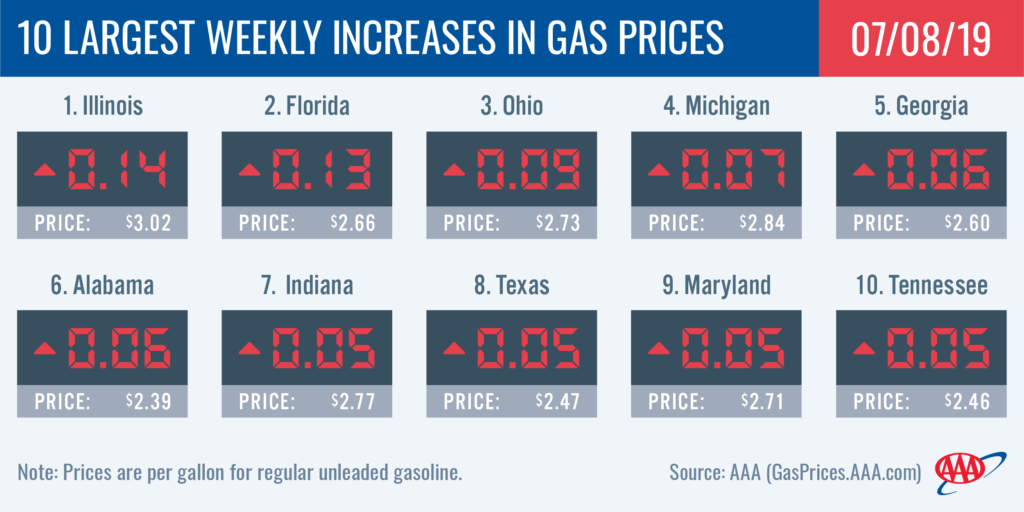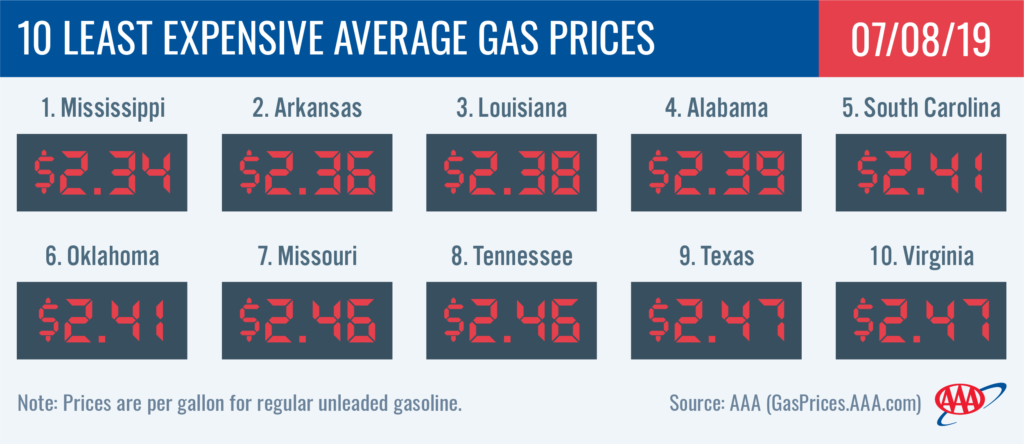 Gas prices are heating up alongside summer temperatures. In the last 15 days, state averages have jumped, pushing up the national average nearly a dime to $2.75. In addition to rising gasoline demand, 13 states this month have introduced new gas taxes that have contributed to the national average increase. Those states include California, Connecticut, Illinois, Indiana, Maryland, Michigan, Montana, Nebraska, Ohio, Rhode Island, South Carolina, Tennessee, and Vermont.
Gas prices are heating up alongside summer temperatures. In the last 15 days, state averages have jumped, pushing up the national average nearly a dime to $2.75. In addition to rising gasoline demand, 13 states this month have introduced new gas taxes that have contributed to the national average increase. Those states include California, Connecticut, Illinois, Indiana, Maryland, Michigan, Montana, Nebraska, Ohio, Rhode Island, South Carolina, Tennessee, and Vermont.
“The only motorists seeing relief at the pump are in a handful of states in the West Coast and Rockies regions where prices are trending cheaper, but still rank among the most expensive in the country,” said Jeanette Casselano, AAA spokesperson. “The majority of motorists can expect more expensive gas prices throughout July, but the national average is still not likely to hit $3/gallon.”
Today’s average is four cents more than last week, but less than one cent cheaper than last month and 11 cents less expensive than a year ago.

Quick Stats
- The nation’s top 10 largest weekly increases are: Illinois (+14 cents), Florida (+13 cents), Ohio (+9 cents), Michigan (+7 cents), Georgia (+6 cents), Alabama (+6 cents), Indiana (+5 cents), Texas (+5 cents), Maryland (+5 cents) and Tennessee (+5 cents).
- The nation’s top 10 least expensive markets are: Mississippi ($2.34), Arkansas ($2.36), Louisiana ($2.38), Alabama ($2.39), South Carolina ($2.41), Oklahoma ($2.41), Missouri ($2.46), Tennessee ($2.46), Texas ($2.47) and Virginia ($2.47).
Mid-Atlantic and Northeast
Despite very low regional refinery utilization, the majority of states in the Mid-Atlantic and Northeast saw gas prices increase no more than a nickel on the week. In Pennsylvania, the state’s gas price average dropped less than a penny on the week. This is a bit counterintuitive considering the Philadelphia Energy Solution (PES) refinery, the largest refinery on the East Coast, is scheduled to close this month. However, with a state average of $2.91, Pennsylvania ranks as the 10th most expensive average in the country.
On the week, Maryland (+5 cents) and Tennessee (+5 cents) saw the largest increases at the pump in the region.
With the PES refinery moving towards closure, regional refinery utilization dropped to 73% and gasoline stocks drew by 2.3 million bbl. The Energy Information Administration (EIA) measures total regional gasoline stocks at 58.5 million bbl, an atypical level for this time of year and a low not seen since December 2017.
According to the EIA, the closure of the Philadelphia refinery would decrease the number of operating East Coast refineries to seven and would reduce (East Coast) gasoline supplies by approximately 160,000 b/d. Gas prices are likely to continue to increase for motorists in the region as retailers look to other options to make up for the deficit caused by the upcoming PES closure.

Great Lakes and Central States
Pump prices are pushing more expensive across the Great Lakes and Central states. Illinois (+14 cents), Ohio (+9 cents), Michigan (+7 cents) and Indiana (+5 cents) rank among the top 10 states with the largest weekly increases. Illinois tops the nationwide chart. Part of the increase can be attributed to new gas taxes that went into effect on July 4 in each of these states.
With the latest jumps, Illinois (+8 cents year over year) is one of only three states in the country to have more expensive gas prices than at the same time last year. Compared to a month ago, Ohio (+13 cents), Illinois (+11 cents) and Michigan (+8 cents) are among states nationwide with more expensive pump prices.
Regional refinery utilization jumped from 93% to 97% according to EIA’s data for the week ending June 28. However, gasoline stocks held at 49.2 million bbl. Should utilization continue to hold strong, it could help to balance stock levels and keep any future gas price fluctuations moderate.
Rockies
Motorists across the Rockies continue to pay less to fill-up at the pump. On the week, pump prices declined between one to four cents across the five states in the region. While the prices motorists are paying are still among the most expensive in the country, they are under $3/gallon: Idaho ($2.97), Utah ($2.94), Montana ($2.79) Wyoming ($2.76) and Colorado ($2.70). Idaho and Utah rank as the eighth and ninth, respectively, most expensive state averages in the country.
Refinery utilization and gasoline stocks remain at strong levels. Stocks had a small add to bump up to 7.6 million bbl, per EIA data. Motorists are likely to see gas prices continue to decrease amid strong utilization and healthy stock levels.

South and Southeast
In the region, four states saw gas prices jump by at least a nickel on the week: Florida (+13 cents), Georgia (+6 cents), Alabama (+6 cents) and Texas (+5 cents).
Notably, all regional state averages are cheaper year-over-year. New Mexico (+25 cents) and Arkansas (+24 cents) have the largest yearly change.
With the latest add, gasoline inventories measure at 84.6 million bbl as regional refinery utilization sits at 95% for the week ending June 28, per EIA data. Stocks could draw in coming weeks should the region be tapped to help make up for the declining stocks in the Northeast due to the pending shutdown of the PES refinery. However, pump prices would likely see only moderate fluctuations.
West Coast
Pump prices in the West Coast region are the highest in the nation, with most states in the region landing on the top 10 most expensive list today. California ($3.76) and Hawaii ($3.63) are the most expensive markets. Washington ($3.34), Nevada ($3.29), Alaska ($3.22) and Oregon ($3.21) follow. Arizona ($2.85) is the only state in the region to fall off the list. Of note, most state averages in the region have decreased on the week, with Alaska (-3 cents) seeing the largest decline. California’s state average is the only to increase, by a penny, last week.
The EIA’s recent report for the week ending on June 28 showed that West Coast gasoline stocks decreased slightly by approximately 200,000 bbl from the previous week and sit at 30.5 million bbl. The current level is similar to levels at this time last year, which could help prices stabilize if there is any disruption in supply or gas demand surges in the region this week.
Oil market dynamics
At the close of Friday’s formal trading session on the NYMEX, WTI increased by 17 cents to settle at $57.51. Crude prices ended last week down from the previous week as global demand concerns continue to worry market observers as the U.S. and China continue to resolve their trade dispute. The fall in prices occurred despite EIA’s data showing that total domestic crude inventories fell by 1 million bbl to 468.5 million bbl. Moving into this week, if it appears that the U.S. and China are not closer to a trade resolution, crude prices could continue to decrease. However, if tension between the U.S. and Iran escalates, crude prices could surge amid market concerns of conflict in the Middle East, which could limit oil flows from the region.
Motorists can find current gas prices along their route with the free AAA Mobile app for iPhone, iPad and Android. The app can also be used to map a route, find discounts, book a hotel and access AAA roadside assistance. Learn more at AAA.com/mobile.

Fuel News, AAA Newsroom, A A A, AAA, AAA Crude, Economy, Expert, Fuel, Fuel Articles, Fuel Commentary
AAA Newsroom: National Gas Price Report for July 8th, 2019
[ad_1]
“The only motorists seeing relief at the pump are in a handful of states in the West Coast and Rockies regions where prices are trending cheaper, but still rank among the most expensive in the country,” said Jeanette Casselano, AAA spokesperson. “The majority of motorists can expect more expensive gas prices throughout July, but the national average is still not likely to hit $3/gallon.”
Today’s average is four cents more than last week, but less than one cent cheaper than last month and 11 cents less expensive than a year ago.
Quick Stats
Mid-Atlantic and Northeast
Despite very low regional refinery utilization, the majority of states in the Mid-Atlantic and Northeast saw gas prices increase no more than a nickel on the week. In Pennsylvania, the state’s gas price average dropped less than a penny on the week. This is a bit counterintuitive considering the Philadelphia Energy Solution (PES) refinery, the largest refinery on the East Coast, is scheduled to close this month. However, with a state average of $2.91, Pennsylvania ranks as the 10th most expensive average in the country.
On the week, Maryland (+5 cents) and Tennessee (+5 cents) saw the largest increases at the pump in the region.
With the PES refinery moving towards closure, regional refinery utilization dropped to 73% and gasoline stocks drew by 2.3 million bbl. The Energy Information Administration (EIA) measures total regional gasoline stocks at 58.5 million bbl, an atypical level for this time of year and a low not seen since December 2017.
According to the EIA, the closure of the Philadelphia refinery would decrease the number of operating East Coast refineries to seven and would reduce (East Coast) gasoline supplies by approximately 160,000 b/d. Gas prices are likely to continue to increase for motorists in the region as retailers look to other options to make up for the deficit caused by the upcoming PES closure.
Great Lakes and Central States
Pump prices are pushing more expensive across the Great Lakes and Central states. Illinois (+14 cents), Ohio (+9 cents), Michigan (+7 cents) and Indiana (+5 cents) rank among the top 10 states with the largest weekly increases. Illinois tops the nationwide chart. Part of the increase can be attributed to new gas taxes that went into effect on July 4 in each of these states.
With the latest jumps, Illinois (+8 cents year over year) is one of only three states in the country to have more expensive gas prices than at the same time last year. Compared to a month ago, Ohio (+13 cents), Illinois (+11 cents) and Michigan (+8 cents) are among states nationwide with more expensive pump prices.
Regional refinery utilization jumped from 93% to 97% according to EIA’s data for the week ending June 28. However, gasoline stocks held at 49.2 million bbl. Should utilization continue to hold strong, it could help to balance stock levels and keep any future gas price fluctuations moderate.
Rockies
Motorists across the Rockies continue to pay less to fill-up at the pump. On the week, pump prices declined between one to four cents across the five states in the region. While the prices motorists are paying are still among the most expensive in the country, they are under $3/gallon: Idaho ($2.97), Utah ($2.94), Montana ($2.79) Wyoming ($2.76) and Colorado ($2.70). Idaho and Utah rank as the eighth and ninth, respectively, most expensive state averages in the country.
Refinery utilization and gasoline stocks remain at strong levels. Stocks had a small add to bump up to 7.6 million bbl, per EIA data. Motorists are likely to see gas prices continue to decrease amid strong utilization and healthy stock levels.
South and Southeast
In the region, four states saw gas prices jump by at least a nickel on the week: Florida (+13 cents), Georgia (+6 cents), Alabama (+6 cents) and Texas (+5 cents).
Notably, all regional state averages are cheaper year-over-year. New Mexico (+25 cents) and Arkansas (+24 cents) have the largest yearly change.
With the latest add, gasoline inventories measure at 84.6 million bbl as regional refinery utilization sits at 95% for the week ending June 28, per EIA data. Stocks could draw in coming weeks should the region be tapped to help make up for the declining stocks in the Northeast due to the pending shutdown of the PES refinery. However, pump prices would likely see only moderate fluctuations.
West Coast
Pump prices in the West Coast region are the highest in the nation, with most states in the region landing on the top 10 most expensive list today. California ($3.76) and Hawaii ($3.63) are the most expensive markets. Washington ($3.34), Nevada ($3.29), Alaska ($3.22) and Oregon ($3.21) follow. Arizona ($2.85) is the only state in the region to fall off the list. Of note, most state averages in the region have decreased on the week, with Alaska (-3 cents) seeing the largest decline. California’s state average is the only to increase, by a penny, last week.
The EIA’s recent report for the week ending on June 28 showed that West Coast gasoline stocks decreased slightly by approximately 200,000 bbl from the previous week and sit at 30.5 million bbl. The current level is similar to levels at this time last year, which could help prices stabilize if there is any disruption in supply or gas demand surges in the region this week.
Oil market dynamics
At the close of Friday’s formal trading session on the NYMEX, WTI increased by 17 cents to settle at $57.51. Crude prices ended last week down from the previous week as global demand concerns continue to worry market observers as the U.S. and China continue to resolve their trade dispute. The fall in prices occurred despite EIA’s data showing that total domestic crude inventories fell by 1 million bbl to 468.5 million bbl. Moving into this week, if it appears that the U.S. and China are not closer to a trade resolution, crude prices could continue to decrease. However, if tension between the U.S. and Iran escalates, crude prices could surge amid market concerns of conflict in the Middle East, which could limit oil flows from the region.
Motorists can find current gas prices along their route with the free AAA Mobile app for iPhone, iPad and Android. The app can also be used to map a route, find discounts, book a hotel and access AAA roadside assistance. Learn more at AAA.com/mobile.
[ad_2]
AAA Newsroom Source link
Post Categories
Latest Post
Newsletter